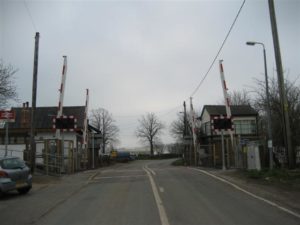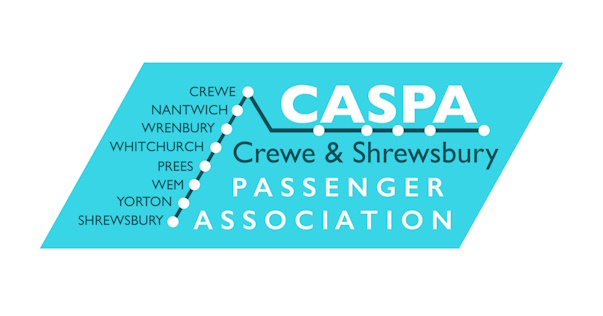
This is a summary of observations at the Wrenbury crossing. This was prompted because of of comments about the long periods of the gates being down. Please send your comments to contact_us@caspa.org.uk
The crossing is located at Wrenbury Station. There is no foot bridge. The platform for the south bound service is before the crossing. The platform for the north bound service is after the crossing.
This is an obstacle detection level crossing with manually controlled barriers. The crossing is initiated by approaching trains and has no direct signaler involvement when working normally, apart from monitoring the process. The obstacle detection equipment monitors the closure of the crossing and determines that the crossing is clear before setting the protecting signal to green.
Activation occurs when a train passes a (“strike-in”) switch probably around 2 – 2.5km from each direction. At 90mph this is 60 seconds away, at 70mph it is 1min 20sec seconds away. For a stopping train with an average speed of say 35mph this is 2mins 40 seconds away. There is another 15 seconds to raise barriers. This gives a minimum for passing train of about a minute and a half.
I have done a very few timings on passing trains and a typical figure appears to be around 2mins 30 seconds. If 2.5kms is right then this an actual speed of about 50mph.
Because of the platform configuration it follows that for all southbound stopping trains the dwell time at the platform and the restart are added to the crossing down time. This adds at least two minutes to the down time for stopping southbound trains compared to north bound. I did one timing on southbound stopped and the gates were down for 6minutes.
There is clearly a concern that passengers from the village must be at the station at least ten minutes before the due time for the southbound train. Otherwise they risk being gated and have to watch their train come and go without them.
There does not appear to be a simple solution to this. The barrier downtime is set by the line speed and appears to be in accordance with the design standards. There is a signalling option for the south bound, of having ‘stopping/non-stopping’ controls. It is then necessary to have a signal between the station and the crossing. A selection device allows the signaller to select appropriate strike-in arrangements for stopping and non-stopping trains. This would save about 2 minutes on southbound stoppers. This arrangement is installed in a similar arrangement at Nantwich where it works well. Southbound stoppers there involve shorter gate down times than north bound stoppers.
As a general observation, the Nantwich gate times (typically 2m 30 sec to 3 minutes) are comparable with Wrenbury. I have no times for Wrenbury northbound stoppers at the moment but I would expect these to be about 3 mins. These times are also very similar to Wem.
Longer down times are possible when two trains pass at the same time. Experience from Wem indicates that this can easily be 10 minutes.
An NR estimate for a pedestrian bridge at Wem is costed at £3m. This would be a similar cost.
Timings taken in November weekday
13.36.00 Stopping south Elapsed mins
Gate down 0
At platform 4.30
Leaves 5.30
Gate up 6.00
13.56.00 Pass south
Gate down 0
Pass 2.30
Gate up 3.00
14.17.00 Pass north
Gate down 0
Pass 1.50
Gate up 2.15
14.23.00 Pass south
Gate down 0
Pass 2.20
Gate up 2.40
Crossing Data
Name: Wrenbury
Crossing Type: Public Highway Manually Controlled Barriers with Obstacle Detection
Location: Wrenbury cum Frith CP
Postcode: CW5 8EX
Route: Wales
ELR: SYC0
Distance: 8 miles 52 chains
Individual risk rating: J (Low)
Collective risk rating: 6 (Moderate)
Last assessment: May 2020
Next assessment due: August 2020
Types of trains: Passenger & Freight
Line speed: 90
Trains per day: 62
Usage:
1026 Vehicles
27 Pedestrians or Cyclists
Misuse history: Nil incidents in year prior to assessment date (Apr-2014), – Nil incidents since.
Near-miss history: Nil incidents in year prior to assessment date (Apr-2014), – Nil incidents since.
Accident history: Nil incidents in year prior to assessment date (Apr-2014), – Nil incidents since.
Key risk factors:
Crossing is Near a Station
Sun Glare
Current protection arrangements:
Road traffic light signals
Full barrier equipment
Train signalling protection
Obstacle detection
Audible alarm
Signage

